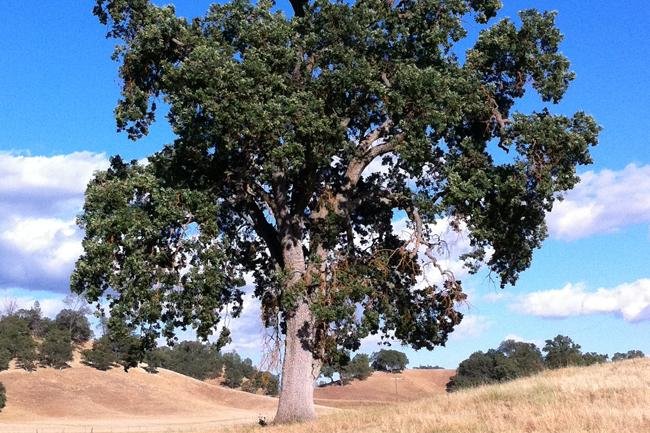California's blue oaks threatened by hotter temps, longer droughts

California's blue oak tree, Quercus douglasii, is the primary species in the state's largest old growth forest ecosystem. Photo by M. Ritter, W. Mark and J. Reimer/Cal Poly
June 29 (UPI) -- The near-five-year drought that dehydrated much of California between 2012 and 2016 led to significant tree cover declines and die-offs.
According to a new study, California's famed blue oak woodlands were especially hard hit.
The latest analysis, published Tuesday in the journal Frontiers in Climate, revealed declines of more than 1,200 square kilometers, or nearly 650 square miles.
The blue oak, Quercus douglasii, which is endemic to California, can be found dotting the foothills of the Sierra Nevadas.
RELATED Climate change to blame for megadrought emerging across Western U.S.
It is the state's most drought-resistant oak species, but the new research suggests the typically resilient tree may struggle to survive more frequent and prolonged droughts.
"Our findings indicate that droughts that last several years, and which occur along with warmer than historically normal temperatures, pose serious threats to the blue oak woodlands," first study author Francis Dwomoh, researcher with ASRC Federal Data Solutions said in a press release.
"Acting in concert with wildfires, these harsher climatic conditions may lead to major tree cover loss, with negative consequences on the plants and wildlife that depend on them, as well as the goods and services we derive from this ecosystem," said Dwomoh, a researcher with ASRC Federal Data Solutions, a contractor to the United States Geological Survey Earth Resources Observation and Science Center.
California's blue oak woodlands are estimated to be the state's most widespread old-growth forest ecosystems, predating the arrival of European colonists.
The woodlands are also host to rich biodiversity, providing food and shelter for more than 300 vertebrate animal species.
Using Landsat satellite images, researchers approximated tree cover losses, as well as conditional changes, among the blue oak woodlands over the last decade. Scientists also used fire records to ensure documented losses were attributable to drought conditions.
The woodlands are also host to rich biodiversity, providing food and shelter for more than 300 vertebrate animal species.
Using Landsat satellite images, researchers approximated tree cover losses, as well as conditional changes, among the blue oak woodlands over the last decade. Scientists also used fire records to ensure documented losses were attributable to drought conditions.
The data showed forests that were both affected and unaffected by fire experienced significant tree cover loses and conditional changes -- partial disruption or degradation -- as a result of the mega-drought that stretched from 2012 to 2016.
The data also showed the negative impacts of wildfires in blue oak woodlands were more pronounced during the drought's hottest, driest years.
"We hope that our research findings will be useful for identifying and prioritizing the most vulnerable areas of the woodlands for appropriate management interventions," Dwomoh said.
"Furthermore, our results might be helpful to plan for more resilient blue oak woodlands and similar landscapes as the harsher climatic conditions of 2012-2016 are likely to be more common in the future," Dwomoh said.
No comments:
Post a Comment